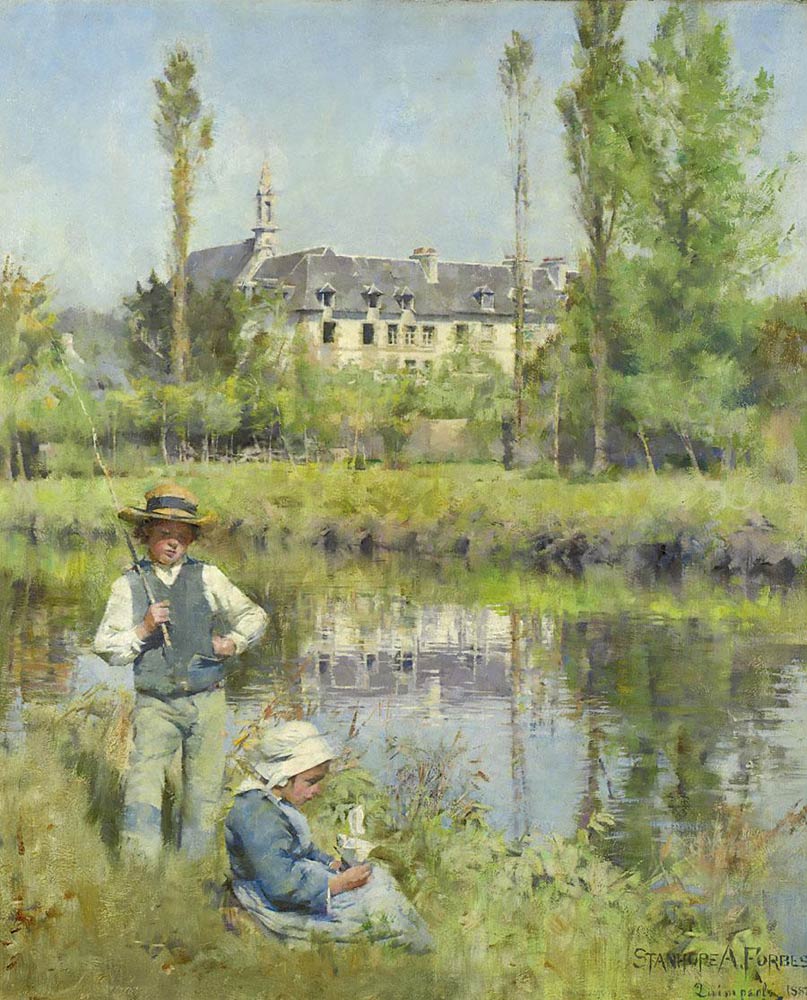
|

|
|
Stanhope Alexander Forbes -- Irish painter (1857-1947) 1882 Private collection Oil on canvas 86.5 x 76cm. (34 x 30 in.) signed, inscribed Quimperle and dated 1882 jpg: Sothebys ‘This was when Forbes knew how to paint light’ (an
anonymous hand-written note by the entry for "The Convent" in the catalogue
of an 1890 exhibition held at Dowdeswell’s London Gallery, now in the collection
of the Victoria & Albert Museum.)
From: Sothebys
Like virtually all the significant artists of his generation, Forbes had made the pilgrimage to France in 1880, settling first in Paris, where he enrolled at Bonnat’s studio. In July 1881, in company with Henry La Thangue, Forbes set out for Brittany, where the two artists moved along the coast to Cancale, near St. Malo. John Singer Sargent had painted his first major plein air work, The Oyster Gatherers of Cancale (coll. Corcoran Gallery of Art, Washington D.C.) there in 1878, and although poor transport links made it less of a draw to artists than some other Breton coastal towns, their stay was important for the development of the ‘square brush’ technique in which Forbes freely acknowledged he took his lead from La Thangue. The first major work produced on this trip, painted in the late summer, was A Street in Brittany, shown at the Royal Academy and bought by the Walker Art Gallery, Liverpool the following year. Forbes was later to recognise that this early purchase of a painting by an institution was instrumental in his decision to become an open-air artist rather than a portraitist. Despite some inaccuracies of scale and perspective and evident difficulties in the painting, the picture has a good deal of charm and the depiction of the model is an excellent essay in ‘square brush’ technique. The summer
of 1882 found Forbes in Brittany once more with La Thangue. This time they
chose Quimperlé, a less popular location than either Pont-Aven or
Concarneau. La Thangue seemed not to like it and left for England in early
June, leaving Forbes alone. The trip was however fruitful for Forbes and
in July 1882 he wrote to his mother to ask her to persuade his wealthy
uncle James Staats Forbes to give up first refusal on The Convent in favour
of James Maddocks, a wealthy Bradford industrialist and important patron
of La Thangue (he had purchased La Thangue’s important Boat
Building Yard (coll. National Maritime Museum, London) in 1881). The
deal was clearly facilitated as the painting entered Maddock’s collection
and was also exhibited the following year at the Royal Academy.
The painting
itself demonstrates not only how far Forbes had progressed since the previous
year, but also the degree to which he had assimilated the work of his contemporaries.
In the spring of 1882, Tooth’s spring exhibition had included Pas Mêche
by Jules Bastien-Lepage (coll. National Gallery of Scotland, Edinburgh),
a large canvas of a ragged small boy. As Bastien-Lepage was seen as the
doyen of the naturalist painters, it seems very likely that Forbes would
have known this painting and the pose of the boy, left hand on hip and
right hand holding a switch over his shoulder, is almost exactly reproduced
in The Convent. A contemporary work by George Clausen, Breton Girl Carrying
a Jar (coll. Victoria & Albert Museum, London), also borrows the stance,
but Forbes uses it as part of a larger composition rather than as a single
figure, here presenting a seated girl holding a toy boat by the standing
boy. The two figures are placed on the near bank of a river which slides
placidly by, giving shimmering reflections of the convent building beyond.
There is a lightness and simplicity to the composition and palette which
come together with remarkable success.
Notes Exhibitions
London, Royal
Academy, 1883, no.1467;
Biliography Mrs Lionel
Birch, Stanhope A.Forbes, A.R.A, and Elizabeth Stanhope Forbes, A.R.W.S.,
Cassell and Company, London, 1906, pp.22-24, illustrated in colour facing
p.22;
Sale Offered for
sale at Sothebys, 02 Jun 04, London, New Bond Street; Session 1,
10:30; Sale L04140 lot 6, estimated 300,000—400,000 GBP
|

By: Natasha
Wallace
Copyright 1998-2004 all rights reserved
Created 5/25/2004